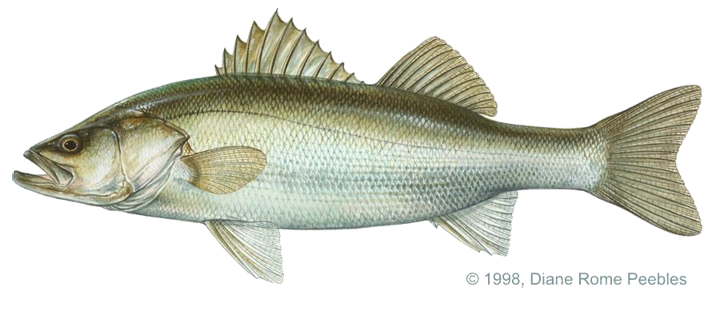Game Fish Identification Reference Guides
Seabass, Japanese (Suzuki)
(Lateolabrax japonicus)
(Lateolabrax japonicus)

(Cuvier, 1828); LATEOLABRACIDAE FAMILY
Endemic to the northeastern Pacific from Japan south to Taiwan and the East and South China seas. It is known to frequent river mouths and shallow inshore bays, surf, and rocky reef areas as well as deeper waters. The young occasionally ascend rivers in summer. It is more wide ranging than its very close “cousin” the blackfin seabass, Lateolabrax latus.
It is elongate and compressed. Its body is less deep and stocky than is that of the blackfin seabass. The tail is slightly forked and the mouth is large with the lower jaw projecting beyond the upper. Young fish have small black spots on the back and dorsal fin. These tend to disappear in larger fish, although specimens from the Ariake Sea, Japan, seem to retain the small spots. Large specimens taken in the Yellow Sea and Gulf of Po Hai have been found to have large, distinct black spots.
The first dorsal fin has 12 15 spines followed by 12 14 soft rays in the second dorsal fin. The anal fin has 3 spines and 7 9 soft rays. The lateral line pore count is 71 86. The Japanese seabass differs from the blackfin seabass in meristics (fin ray counts), body depth, and other characteristics. (See blackfin seabass.)
Claims submitted to IGFA for record consideration have shown white, clear, or dusky (but not black) dorsal fin spines and membranes. The body above the midline is generally darker than in the “blackfin” species, which is more silvery and usually lacks spots.
Japanese seabass spawn from November to January in the deeper rocky reef areas near bays. After spawning they move into shallow waters to feed. Their diet includes sardines, anchovies and shrimp, as well as other small fishes and crustaceans. They can be taken by bait fishing with small fish or crustaceans, or by slow trolling, jigging, or casting with feathers, plugs, flashy jigs or spoons at any level from the bottom to the surface. Best fishing is said to be at night and dawn near the surface. The largest fish are caught in fall and winter. As a food fish or a game fish the Japanese seabass is very highly rated
Endemic to the northeastern Pacific from Japan south to Taiwan and the East and South China seas. It is known to frequent river mouths and shallow inshore bays, surf, and rocky reef areas as well as deeper waters. The young occasionally ascend rivers in summer. It is more wide ranging than its very close “cousin” the blackfin seabass, Lateolabrax latus.
It is elongate and compressed. Its body is less deep and stocky than is that of the blackfin seabass. The tail is slightly forked and the mouth is large with the lower jaw projecting beyond the upper. Young fish have small black spots on the back and dorsal fin. These tend to disappear in larger fish, although specimens from the Ariake Sea, Japan, seem to retain the small spots. Large specimens taken in the Yellow Sea and Gulf of Po Hai have been found to have large, distinct black spots.
The first dorsal fin has 12 15 spines followed by 12 14 soft rays in the second dorsal fin. The anal fin has 3 spines and 7 9 soft rays. The lateral line pore count is 71 86. The Japanese seabass differs from the blackfin seabass in meristics (fin ray counts), body depth, and other characteristics. (See blackfin seabass.)
Claims submitted to IGFA for record consideration have shown white, clear, or dusky (but not black) dorsal fin spines and membranes. The body above the midline is generally darker than in the “blackfin” species, which is more silvery and usually lacks spots.
Japanese seabass spawn from November to January in the deeper rocky reef areas near bays. After spawning they move into shallow waters to feed. Their diet includes sardines, anchovies and shrimp, as well as other small fishes and crustaceans. They can be taken by bait fishing with small fish or crustaceans, or by slow trolling, jigging, or casting with feathers, plugs, flashy jigs or spoons at any level from the bottom to the surface. Best fishing is said to be at night and dawn near the surface. The largest fish are caught in fall and winter. As a food fish or a game fish the Japanese seabass is very highly rated













